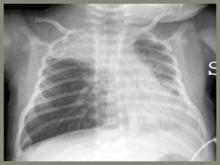SAN DIEGO – Inappropriate use of bronchodilators to treat pediatric bronchiolitis declined from 70% of patients in 2007 to 58% in 2010, thanks to benchmarking and peer-to-peer collaborative efforts of the Value in Inpatient Pediatrics Network at hospitals in 14 states.
Bronchodilator utilization decreased by 45% as measured by doses per patient, from 7.6 doses/patient in 2007 to 4.2 doses/patient in 2010, Dr. Shawn Ralston and her associates reported at the annual meeting of the Society of Hospital Medicine.
Inappropriate use of chest physiotherapy to treat pediatric bronchiolitis also declined, from 14% of cases in 2007 to 4.2% in 2010, said Dr. Ralston, chief of the division of inpatient pediatrics at the University of Texas Health Science Center, San Antonio.
The investigators had hoped to see declines as well in the inappropriate use of chest x-rays, steroids, and testing for respiratory syncytial virus, but mild declines in these categories did not reach statistical significance.
Bronchiolitis is the most common reason for hospitalizing infants and toddlers, with wide variation in care. Practice guidelines from the American Academy of Pediatrics (AAP) in 2006 recommend treating pediatric bronchiolitis with nothing but supportive care. Bronchodilator therapy and steroid therapy have been shown to have no benefit for these cases in repeated meta-analyses over the past 15 and 12 years, respectively.
"None of the things we all do frequently have any support" in the literature for managing pediatric bronchiolitis, Dr. Ralston, a steering committee member of the Value in Inpatient Pediatrics (VIP) Network.
The VIP Network, formed out of an AAP section on hospital medicine, pulled together physicians who were frustrated with the lack of pediatric resources for quality improvement in smaller academic and community hospitals. The VIP Network chose bronchiolitis as its first target to see if it could start to change management by providing a peer group for local leaders to share resources and benchmark progress within the group.
The VIP Network functions as a virtual community with yearly meetings that adopted group norms for appropriate bronchiolitis care. Its website offers handouts, bibliographies, and other resources, and network members provided peer-to-peer coaching on quality improvement.
Members produced yearly benchmarking reports using hospital billing data for diagnostic codes 466.11 or 466.19 starting in 2008 (with some 2007 data serving as additional baseline data). Dr. Ralston said that 90% of data came from non-freestanding children’s facilities. In all, 70% of participating facilities did not have a guideline for pediatric bronchiolitis management prior to joining the Network, Dr. Ralston said. A total of 30% of facilities were in urban locations.
The results show that an all-volunteer group with no source of specific funding and no new resources can make real-world changes that improve the quality of care, she said.
"The caveat is that it has to be something the physicians really care about," she said. "Clinicians are significantly more motivated for this kind of work than researchers."
Dr. Ralston reported having no financial disclosures. She receives funds from the American Academy of Pediatrics to be editor of the journal Hospital Pediatrics.



